"Threadless Corner"
by Ray Klingensmith
Reprinted from "INSULATORS - Crown Jewels of the Wire", October 1980, page 3
REPORT ON THE HERKIMER THREADLESS DISPLAY
To start this report, I
find myself asking: "How can you begin to tell a story as great as
this?" So I guess the most logical point would be from the very beginning
of the idea to attempt the display. Three or four years ago some west coast
collectors got together and put on a group "EC&M" display that
really went over big. From that time on there was always the idea of doing it
with threadless someday. Last fall, after attending McDougalds' outdoor show,
Skip Plunkett and I went threadless digging for a few days in New York. After
crawling through blackberry bushes and grape vines for a couple of days, both of
us had pretty much told all our past insulator experiences and tales, so we
looked at the future of the hobby and began talking about how great it would be
to get one of every known threadless in one big display. The Herkimer National
was less than a year away, and we both agreed it would be a great place to
attempt such a project. Well, we sort of left it at that; but a couple months
later we got serious about the whole thing and decided to go ahead with it. A
few of the owners of large threadless collections were notified, and most seemed
somewhat willing to participate. A few rules and guidelines had to be set up,
and then most realized it was an organized effort, and more contributors decided
to take part.
The show crept up very quickly, and, as usual, my part of the work
turned into a last minute effort -- building lighted display cases, calling
contributors, buying needed material, making trophies. It all got pretty hectic,
but it all got done. (Thanks, Hans Kettenburg, for saving everything!) Well, we
all arrived at Herkimer and found a huge building. Grant Barnes informed me the
Threadless display was right in the center of the display area where everyone
could see it. It was perfect. He also informed me about the 24 hour security and
how the guard was going to be glued to that display area. (Maybe I wouldn't have
a stress attack after all.) We set up the tables, and after half a dozen people
made sure they were locked tight and wouldn't fall over, we put the display
cases on and got them ready.
Finally, at 11:00 A.M. Friday, the Paul Plunketts
and I started carefully putting the items in. Wouldn't you know it -- about ten
collectors brought their items at one time. I tried to remain calm. Then people
started coming inside the roped area (Oh, Hans, save me from a stress attack!).
So we calmly explained all the rules to everyone about not being inside the
roped area, plus a few other points, and most cooperated. We wondered if we
would reach our goal of 300 different insulators. Collectors kept bringing them,
and we kept putting more in the cases. We started to wonder if everything would
fit in the five lighted cases! After about four hours of a hectic pace, Bill
Plunkett brought everyone a glass of Coke, and we took a badly needed break. I
went over to my sales table and sat down in a daze. Hans wondered why I was so
white, and I explained about the stress attack I was finally having. We got back
to the display, where Skip was ready and eager to carry on. Just when I thought
we were almost done, I looked up at the table where Mrs. Plunkett had been
unwrapping insulators, and saw over 100 more from their collection we had to
sort through yet! Well, we pushed on and, finally after five hours and 20
minutes, we had it all set up. Finally we could step back and take a look at it.
It was incredible -- no it was more than that -- there were no words for it. You
couldn't begin to realize what was there. It was before your very eyes, but it
still didn't seem real. Collectors started rushing forward, and for 40 minutes
all you could see was camera flash bulbs flashing and the sound of film rolling
forward. Everyone abandoned their sales tables to take a look. Kevin Lawless
took a count of items in the cases and informed us there were exactly 300. We
reached our goal -- right to the exact number of insulators. And we had a couple
to spare on the table.
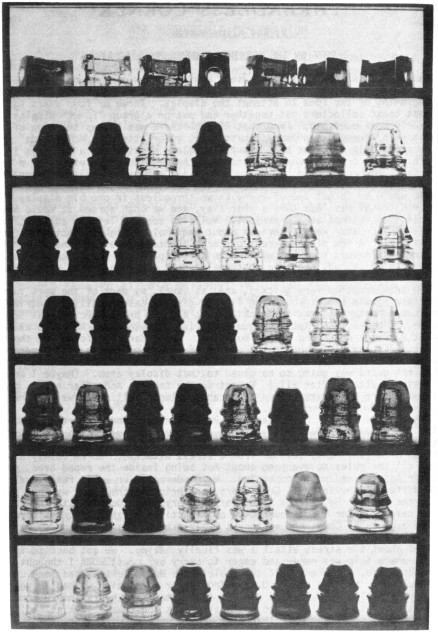
Large Image (237 Kb)
CASE A
Photo by Hans Kettenburg
|
Row
1:
|
Glass blocks -- milky green, reverse slot blue, yellow green, forest green,
emerald green, dark amber, olive amber
|
|
Row 2:
|
731 deep amber, 731 deep amber
color variant, 731.2, similar to 731 deep amber "Stoddard type", S.
McKee & Co blue, S. McKee & Co blue mold variant, concave skirt M on
dome
|
|
Row 3:
|
731 deep olive, 731 deep green, similar to 731 (V wire groove)
milk-glass, 733 Brookfield mold #5, 728, 765 embossed Oakman, similar to 728
unembossed slotted pinhole
|
|
Row 4:
|
Deep green mlod 732, amber variant mlod 732,
amber variant mlod 732, amber variant mlod 732, (all remaining 732's will be 3
piece mold) blue aqua 732, 731 Brookfield, 733 Brookfield mold #1
|
|
Row 5:
|
Milky
jade 732, sage-celery 732, medium-dark green 732, dark forest green 732, green
aqua with slag 732, very milky blue 732, ginger ale 732, mint-lime 732
|
|
Row 6:
|
729.1 aqua, 729.1 dk. green variant, 729.1 black glass, aqua with slag streak,
aqua, 731 aqua, 733.2 M
|
|
Row 7:
|
Unembossed "Milholland #1", same
embossed PAT APP FOR, 729 Mulford & Biddle 83 John St, 729.1 dark amber, 729
green variant, 729.1 green variant, 729.1 deep yellow olive, 729 deep amber
|
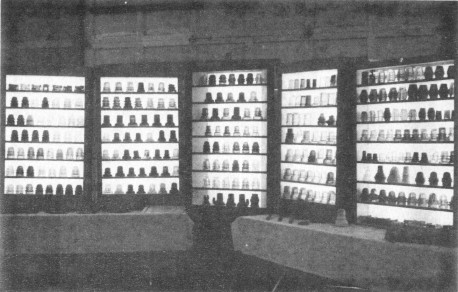
Photo by Mike Bruner
Right after completion of setting up the display -- showing
the five display cases filled with 300 different jewels and the several items on
the tables.
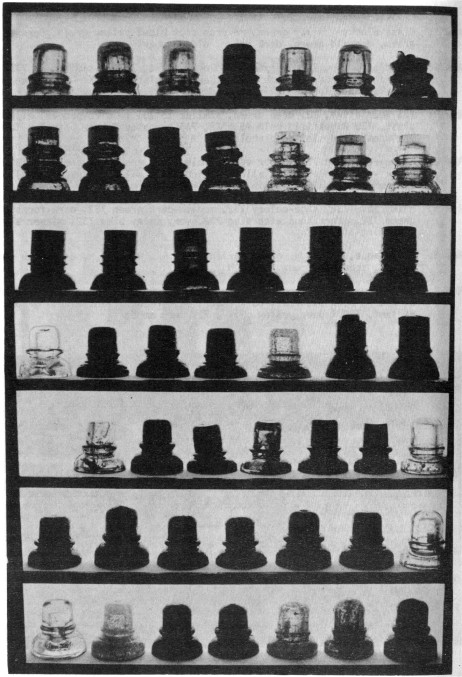
Large Image (218 Kb)
CASE B
Photo by Hans Kettenburg
Row 1:
|
741
smooth aqua variant, 741 rippled aqua variant, 741 rippled aqua variant, 741
puce rippled, 741 smooth azure-cornflower blue, 741 smooth green, 736 NY&ERR
puce (broken)
|
Row 2.
|
(First 4 are all large "Erie" type 736's) dark
aqua, dark aqua with tiny bubbles, dark green, medium green, bubbly aqua
NY&ERR embossed 2 sides), green color variant NY&ERR (embossed 2 sides),
aqua NY&ERR (embossed on one side)
|
Row 3.
|
Dark olive 737, dark olive 737,
dark forest green 737, dark amber 738, dark teal blue 738, dark green 738
|
Row 4.
|
740 aqua, 740 bubbly green (with ring below w/groove), 740 green variant, 740
dark amber (with extra ring), 740 bubble filled (with extra ring), dark waxy
olive X-Top, dark amber X-Top
|
Row 5.
|
Light green Dupont, 740 dark color variant,
740.2 "tilt" deep olive or amber, 740.2 "Tilt" green, 740.2
deep color variant, base embossed Mexican similar to 740.2 and 735, 743 aqua
with streaks
|
Row 6.
|
First five are deep color and style variants of 740, dark
green "extra ring" 740, 743 aqua
|
Row 7.
|
"Extra ring" aqua
740, "extra ring" snow filled 740, deep colored 740, deep colored 740,
bubble filled 743, slag and bubble filled 740, deep colored 740
|
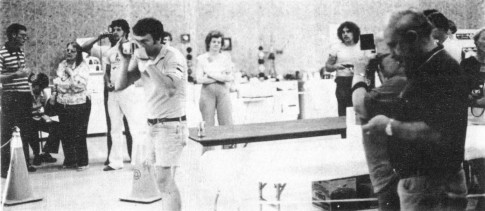
Photo by Hans
Kettenburg
The display finally set up. The crowd of viewers and photographers
beginning to assemble. From left to right -- Bob Pierce answering lady's question,
security guard lights up a Salem to calm her nerves, unidentified lady asking
Bob Pierce if they're all his (Bob says yes!), Len Linscott poking lady in head
with elbow, Ray Klingensmith -- "I don't believe it", Steve Bobb up
close, lady in center with arms crossed asking if "any of you are
sane?", New York State? collector hoping to find one someday, Phoebe Adams
taking a picture of Steve!, Bill Dreggors trying to decide if the camera was
facing the display or himself on the last shot, Skip Plunkett trying to decide
which "dooger" he'll find with his "roto-rooter" on the next
digging trip, and finally Mrs. Wm. Plunkett patiently waiting for the crowd to
thin out.
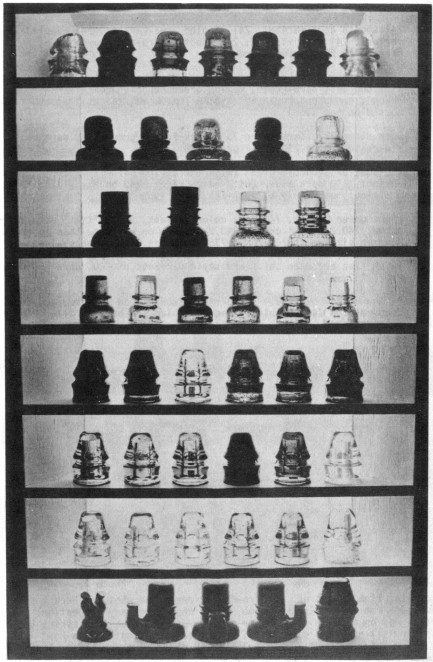
Large Image (207 Kb)
CASE C
Photo by Hans Kettenburg
Row 1.
|
Aqua J S
Keeling 16 Broadway, black glass Keeling, teal blue Keeling, green 718 Tillotson
16 Broadway NY,, deep green 718 Tillotson, olive 718 Tillotson, aqua 718
Tillotson
|
Row 2.
|
Dark amber 740 Tillotson 16 Broadway NY, medium-dark olive
apple green 740 Tillotson, bubble filled green 740 Tillotson, deep amber 740
Tillotson, aqua 740 Tillotson
|
Row 3.
|
Black glass (737-738) Tillotson 26 Dey St.,
738 Chester NY dark orange amber, 736 blue Tillotson 16 Broadway, 736 blue-aqua
Tillotson
|
Row 4.
|
All 735 Tillotsons!--medium green, aqua, olive green, bubbly
medium green, blue aqua, light aqua
|
Row 5.
|
All 731 Tillotsons!--dark amber, dark
olive amber, sapphire blue, bubble filled green, green, green with slight blue
tint
|
Row 6.
|
All 731 Tillotsons!--aqua variant, aqua variant, green aqua, deep
cobalt, medium dark teal blue, light aqua
|
Row 7.
|
First 5 731 Tillotsons--aqua
variant, sage-yellow green, blue with cobalt streaks, blue variant, blue
variant, 732 LGT & CO. Row 8. Deep olive amber "Slashtop", teal
green T-Pot, green T-Pot, teal green T-Pot, large "Confederate egg"
olive green
|
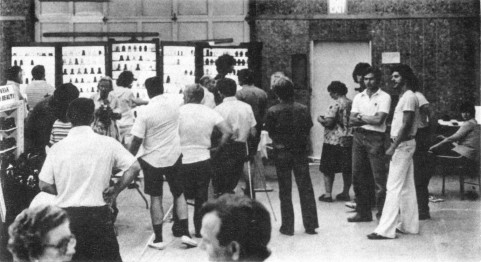
Photo by Hans Kettenburg.
The crowd getting larger. Is that Doug
MacGillvary in the front row wishing this was his sales table? Notice our ever
alert security guard seated at extreme right. Ever seen such a group as this
with such bad manners -- to turn their backs on the photographer?
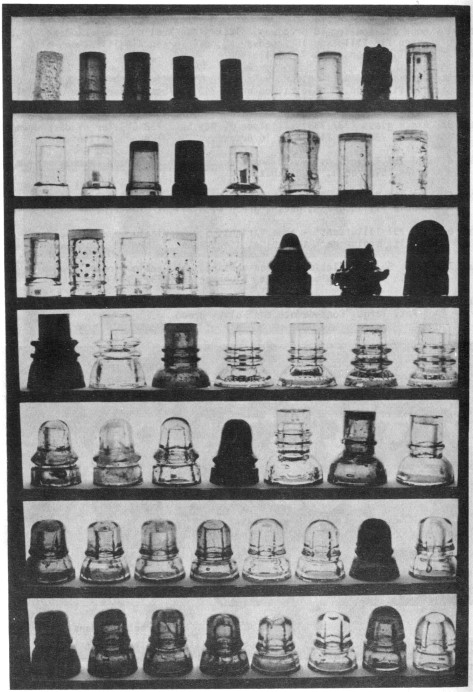
Large Image (211 Kb)
CASE D
Photo by Hans Kettenburg
Row 1.
|
Bubble filled aqua "baby
Wade", same green variant, same green variant, "ring skirt"
"Canadian Chester type insert", same only shorter, light aqua tapered
top "baby Wade", same cornflower blue, partially wood covered baby
Wade, Mt. Washington smooth Wade type in light yellow green
|
Row 2.
|
Pink 724,
celery green 724, cobalt 724, deep cobalt 724, 724.5 celery green, "concave
Wade", smooth Wade 723, dot-dash 723
|
Row 3.
|
Dot-dash variant, dot-dash
variant, dot-dash light green color variant, dot-dash light green color variant,
dot-dash near clear, 727 medium-dark green, "flare skirt" Chester type
insert with wood and iron ring, wood covered Wade
|
Row 4.
|
Deep green narrow dome
similar to 744, same very light green-aqua, Lefferts dark aqua, Lefferts aqua
variant, Lefferts aqua variant, bubbly lime green ERW, blue aqua ERW
|
Row 5.
|
726
aqua variant, 726 aqua with milky streaks, 726 unusual grey color, 726 plum
colored (red-purple mixture!), 739, 735.6 "Big Green", 735.6 "Big
Blue"
|
Row 6 & 7.
|
Embossed M.T.CO and unembossed, not in this order:
full of milk MT CO, electric blue M.T.CO., teal green MT.CO., light blue M.T.
CO, aqua M.T.CO, unembossed in electric blue, aquas, green, blues. Last two in
row 7 are: green (close to 7 up) beehive, and an aqua beehive
|
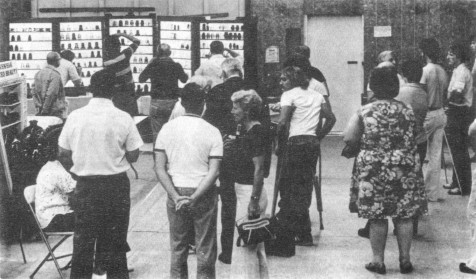
Photo by Hans
Kettenburg
Flash cubes fast at work. If one had a dollar for every picture
taken, he could buy his choice of any item in the display! Who is that poor guy
in the center on crutches who can't get through the crowd to get a closer look?
Standing in front of Miss H.G. Beehive is our security guard, who got off her
chair long enough to take a look at the treasure she was guarding.
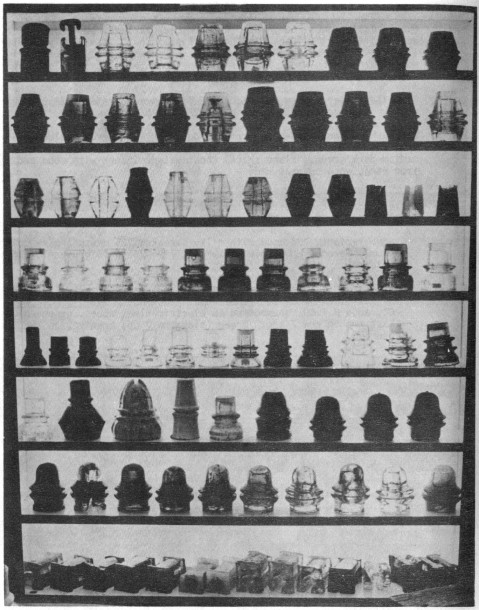
Large Image (269 Kb)
CASE E
Photo by Hans Kettenburg
Row 1.
|
The "Haley" mixed
colors, "Lefferts type" glass ramshorn, yellow green style B egg,
style C near clear, style B bubbly aqua, style B light lime-mint green, style B
clear with beige cast and milky streak, tan porcelain egg, grey porcelain egg,
tan porcelain egg with nail in skirt
|
Row 2.
|
Narrow top--wide groove egg style G
in deep green, 7 up green variant style B, same, same (all 3 are different
shades), blue aqua style B, "Confederate" color variant, large style
E, style A dark teal, style I dark green, style B bubbly aqua
|
Row 3.
|
Nine
thru-pinhole eggs: dark SCA, medium SCA, sage green, dark amber (tall), bubbly
clear, bubbly clear, aqua, dark olive, dark green?, black sleeve, vaseline
sleeve, aqua sleeve
|
Row 4.
|
Dark aqua 735 Mulford & Biddle, light aqua
Mulford & Biddle, yellow green M&B, snowy aqua M&B, green UPRR,
cobalt UPRR, cobalt UPRR, aqua UPRR, 735 So Ex Co, dark aqua U.S. TEL CO, light
aqua US TEL CO.
|
Row 5.
|
Composition Goodyears patent, straight skirt Baby
Battleford, Baby Battleford, aqua Baby Battleford, light aqua 734.1, McMicking,
737.5 real light green, 737.5 medium yellow green, similar to 737.5 black glass,
741.2, 736.4 clear, same style as NY&ERR only about 2/3 as big--unembossed
blue, same green
|
Row 6.
|
735 light aqua Chester NY, Bennington Threadless, eared
Elliot porcelain, "Slim Jim" porcelain, aqua Mulford & Biddle with
iridescence, 729.1 shiny deep green, next three are 718's in deep yellow olive,
deep green, deep olive amber
|
Row 7.
|
718 deep purple, 718 unusual "ginger
ale-pink-light puce color!", 718 medium green (previous 3 all have extra
ring at base), 718 medium dark cobalt, light cobalt, blue, aqua variant,
olive-milky streaked aqua, aqua variant, milky streaked blue aqua
|
Row 8.
|
14
glass blocks consisting of (and not in this order) slag glass variant, slag
glass variant, reverse slotted aqua, dark yellow amber, light milky green, clear
aqua, kelly green, short aqua, tall aqua, frosted aqua, snowy green, snowy
green, dark amber variant, green variant
|
"ON THE TABLES"
Not pictured
in the lighted cases already described, but displayed either throughout the show
on the display tables, or items which were removed (prior to, or put in after
the photos were taken, included the following:
Four style A deep green eggs on
original iron side brackets, 736 large "Erie" type -- green, two 1868
"Southern Express Company" bills of lading, three small wooden
threadless pins, one long threadless wooden side bracket, flat-top wood covered
Wade, regular wood covered Wade, Wade with partial wood covering, "Chester
type" iron ring for wood covered insulator, paneled Elliot porcelain hat,
original transcontinental telegraph line ramshorn in wood block, two original
transcontinental railroad crossarms with ramshorns, 735 Chester NY in light
green, a 735 Chester NY which was a very light aqua with loads of medium amber
streaking!, two aqua Tillotson 26 Dey Street hats that could pass for either 737
or 738, embossed Oakman similar to 728, and a 740 bubbly aqua Dupont.
The
next morning all of us arrived back at the show and made some minor adjustments
and finished up on what needed to be done. Those in attendance were told they
could make one vote on what they felt was the "most desirable"
insulator in the display. If you stood near the display, all you could hear was
the question, "How can you choose just one?" It was a hard decision
for most people, and some took advantage of the full three hours to make up
their minds. At noon, the following people received recognition for having
contributed insulators to the display: Marilyn Albers, Graham Barnes, Grant
Barnes, Dick Bowman, Jim Cunningham, John de Sousa, Jim Gruhl, Dave Haley, Jack
Hayes, Frank Jones, Mike Johnson, Fritz Kettenburg, Hans Kettenburg, Ray
Klingensmith, Mr. and Mrs. R. H. Klingensmith, Ray Lanpher, Kerry Lavendoski,
Doug MacGillvary, John and Carol McDougald, Tom Moulton, Don Otis, Pat Patocka,
Bob Pierce, Joe Pierson, the Bill Plunkett family, the Paul Plunkett family, Bob
Roosevelt and Claude Wambold. All these people deserve a real big THANKS for
letting everyone see items from their collections.
Special recognition should
also be given to the following people for their help: my sister Debbie for
watching my sales table and helping to organize the display; my mom and dad, who
helped build the display cases and let me use their vehicle to haul all the
display cases and equipment to far away Herkimer; Hans Kettenburg, who helped
build the display cases, kept things organized, and also saved me from so many
"stress attacks"; John and Carol McDougald, who donated a 1980
National Commemorative to be used on the "Most Desirable Threadless"
trophy; both Plunkett families for so much help in so many ways; and especially
(I'm sorry you are last in this alphabetical listing) a big thanks to Skip
Plunkett. Skip put in a lot of time on this project and really didn't get the
credit he deserved. He spent time in the early stages contacting people, and was
right there at my side during the whole set-up, also handling the job of
getting the majority of the items back to their owners. Most of the people at
the show seemed to think I did all the work, but that was far from the truth.
Skip put a great deal of time into this, and I hope he will get a good part of
the credit he deserves.
Those who displayed items were all presented a trophy
made from two crosscut sections of telegraph poles. One was from a 1927 pole
used on the Erie R.R. The other was a 1951 pole placed in use on the Erie in
celebration of the centennial of the opening of the New York & Erie R.R.
back in May, 1851. The "most desirable" trophy also made use of the
cross-sections and also the 1980 Commemorative insulator. Kevin Lawless tallied
the votes for the "most desirable award (Thanks, Kevin) and informed me
only one vote separated the number one item from the second place item. The
award went to Jack Hayes for his CD 726 plum colored beauty. One vote behind was
Paul Plunkett's CD 718 cobalt, and a few votes behind, in third place, was the
CD 738 amber Chester. After these three the voting was widely scattered among
several really nice items. Like so many said, "How can you vote for just one?!"
Throughout the rest of the show, everyone took advantage of the
spare moments they had to view the display. We all knew it would have to come to
an end. I personally could have spent another week at the show, but the display
had to be taken down and everyone head home. Now that it's all over, I'm sad I
didn't take more time to really look at the items. Looking at the photos now,
it's hard to believe there was so much there. Many asked when it would be done
again. My reply was an honest one -- I don't think you could ever do it again and
get the response we did this time. Two or three years from now would be too soon
for the people who helped now; and in four or five years, who knows where we'll
all be. But maybe, just maybe, it is possible -- perhaps we should start seriously
planning -- yes, maybe -- maybe we'll try it again in '89!
Thanks to Mike Bruner
for the photo of the whole display, and to Hans Kettenburg for all the other
photos.
|
